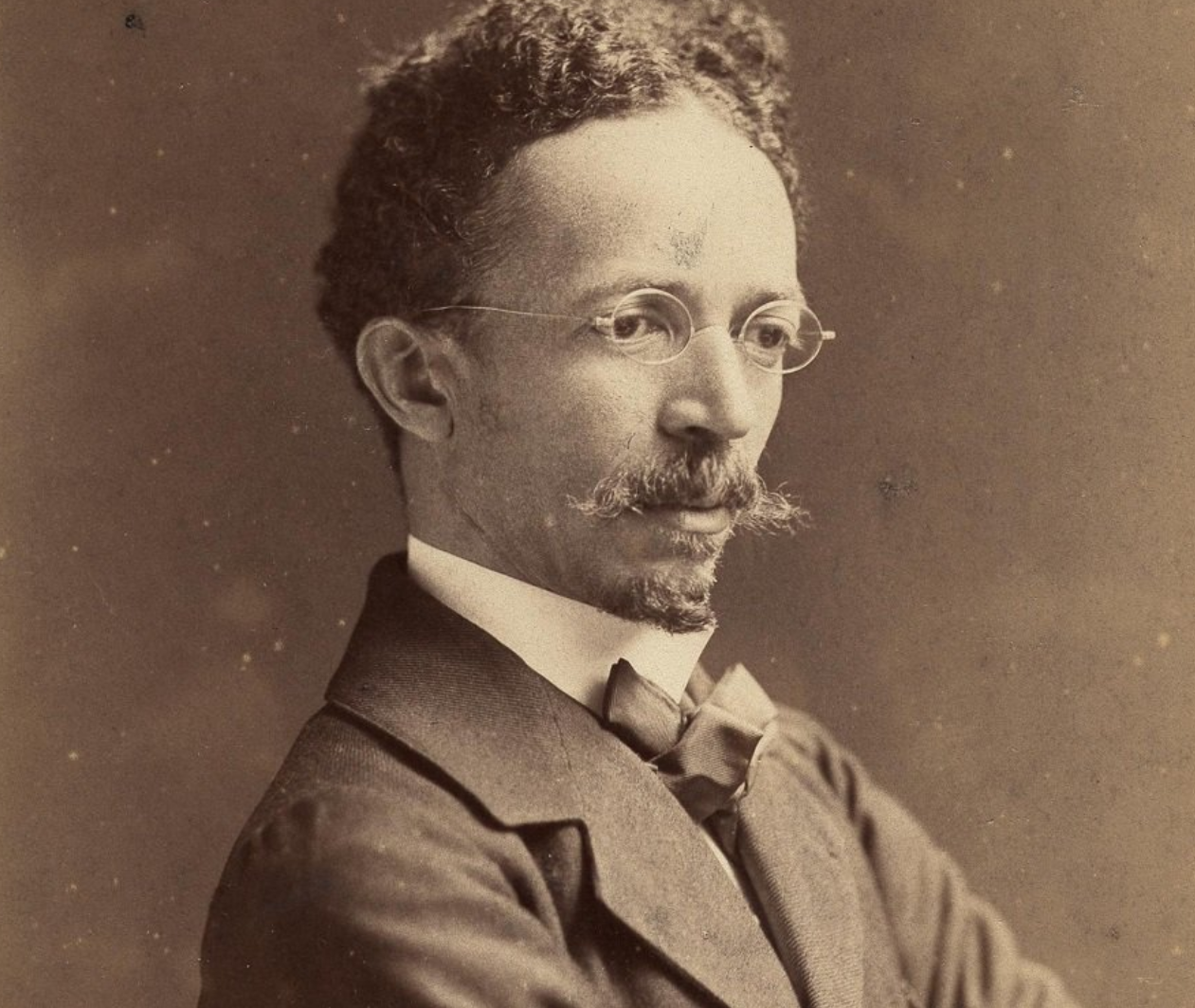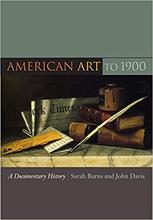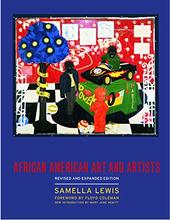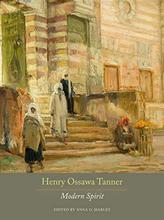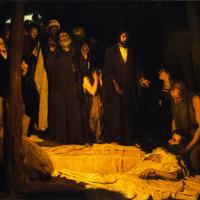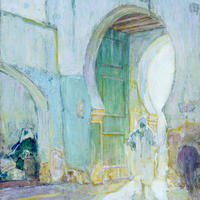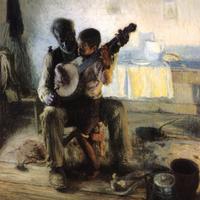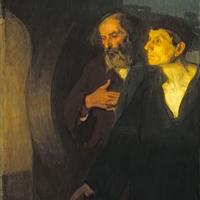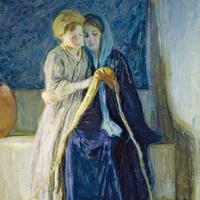More about Henry Ossawa Tanner
- All
- Info
- Shop

Contributor
In West Philadelphia, born and raised, in the playground where I spent most of my days…
No, I’m not talking about Will Smith. I’m talking about Henry Ossawa Tanner, the first African-American artist to make it big not only overseas, but domestically. Crazy considering Jim Crow was still in effect.
Tanner started out his work in 1876 painting landscapes, harbors, and animals at the Philadelphia Zoo. Four years later, he became the only African-American enrolled at the Pennsylvania Academy of Fine Arts under the tutelage of Thomas Eakins, who influenced much of his style. By 1888 he moved to Atlanta, modern day home of Southern trap music, but at the time, a bastion of good old Southern racism. It was a big contributor to his failures in both beginning a photography business and selling any work at one of his first exhibitions. However, it wasn’t all bad: a Cincinnati bishop by the name of Joseph C. Hartzell helped him secure a teaching position at Clark University and bought all the paintings he didn’t sell (read: all of them) at the aforementioned exhibition. Still, it wasn’t enough for Tanner, who wished to be recognized on his merits as an artist.
Nineteenth-century Paris was an artist’s Mecca. Art schools, museums, and exhibition spaces were in high abundance, and the average Parisian believed that art was integral to everyday life. The architecture and food were but pluses to such a boon to one’s career, so much that Americans were the largest contingent of foreign visitors and immigrants to the City of Light. It was there that Tanner would go to in 1891, enrolling at the Académie Julian to further his craft.
At that point, it was history. By 1894 his works were exhibited at the Paris Salon. In 1896 he got an honorable mention for a now lost, 1895 version of Daniel at the Lions Den. One year later he won a medal at the same exhibition for The Raising of Lazarus, rare for an American, but even more so for a black American. The work was exceptional enough to be personally bought by the French government.
Following a two-year trip to the Holy Land to gather more material for his work, he won the PAFA’s Lippincott Prize for Nicodemus Visiting Jesus and another medal at the Universal Exposition, also in Paris. Then after that, he took a break to serve in World War I as a member of the American Red Cross, upon after he was made a chevalier in the Legion of Honor in 1923 and the first African American to be granted full membership to the National Academy of Design in New York.
There’s no stopping this guy. Alexa, play “WIN” by Jay Rock.
It’s amazing that the son of a slave, herself the granddaughter of a plantation owner could achieve so much in his lifetime. As a mixed-race person, Tanner felt more at home abroad than he ever did in the States, and his trek to the Holy Land only amplified that tenfold. His depictions of Jesus fluctuate between as black as Huey Freeman envisioned him to white as snow throughout his career, a possible reflection of not only the cosmopolitan influences of the Holy Land, but also his struggles with race.
So before you mention Basquiat in conversation as one of the first African American artists to really make it big in the Western World, don’t forget to look to Tanner as a predecessor.
Sources
- Braddock, Alan C. "Painting the World's Christ: Tanner, Hybridity, and the Blood of the Holy Land." Nineteenth-Century Art Worldwide. 2004. Accessed December 09, 2018. http://www.19thc-artworldwide.org/autumn04/298-painting-the-worlds-chri…
- The Editors of Encyclopaedia Britannica. "Henry Ossawa Tanner." Encyclopædia Britannica. June 17, 2018. Accessed December 09, 2018. https://www.britannica.com/biography/Henry-Ossawa-Tanner.
- Weinberg, H. Barbara. "Americans in Paris, 1860-1900." Heilbrunn Timeline of Art History. October 2006. Accessed December 09, 2018. https://metmuseum.org/toah/hd/ampa/hd_ampa.htm.

Contributor
Henry Ossawa Tanner managed immense international success as an artist despite constant, whale-sized, racial roadblocks.
Henry Ossawa Tanner was born in Pittsburgh, Pennsylvania in 1859. Like so many of the great artists in this world, Tanner’s parents did not want him to become one. In fact, his family offered little support to the cause at all. They wanted him to follow the family tradition of studying theology and becoming a preacher. But Tanner had a talent and drive to succeed that simply could not be stifled. By the time he was 17 years old, he was producing art that gained him attention.
As an artist who would accomplish many “artistic firsts” throughout his career, Tanner’s first first was when he became the first and only African American to attend Pennsylvania Academy of the Fine Arts. After this, Bishop Hartzell from Cincinnati took a deep personal interest in Tanner’s work and helped him get a job as a teacher at Clark University to support him financially. Hartzell also put together an exhibition of Tanner’s paintings, and when it failed to sell, he purchased all the paintings himself to help fund Tanner’s travels to Europe. Tanner used this money to travel to Rome where he intended to study with the many great Roman religious painters. On his way to Rome, he stopped in Paris and fell in love with the city. He would stay there for the rest of his life (never studying in Rome), although he would also return to the United States frequently to sell paintings and give academic presentations.
Tanner began to achieve recognition for his biblical scenes (which brings us full circle to his biblically oriented upbringing - he still made his family proud in the long run!). In 1894 Tanner’s paintings were exhibited at the Paris Salon, and by 1897 his painting The Raising of Lazarus had won a gold medal from the Paris Salon (a feat almost no other American artists accomplished). And as if this wasn’t enough achievement for Tanner already, the French government then went on to purchase the painting from him.
Toward the end of his career, he served in World War I for the American Red Cross in France. He won a Legion of Honor for his service and then returned to the art scene. He unfortunately received much less attention for his art post-war. When he passed away in 1937, his popularity continued to decline until 1967 when the Smithsonian exhibited a handful of his works in what was also the first ever American exhibition featuring a Black artist. This triggered the beginning of a much delayed, but much needed, revival of Tanner’s work!
Sources
- Tanner, Henry Ossawa." Britannica Online Academic Edition, 2018, Encyclopædia Britannica, Inc.
- "HENRY OSSAWA TANNER." Negro History Bulletin 2, no. 7 (1939): 59.
- National Gallery of Art." Artist Info. Accessed September 21, 2018. https://www.nga.gov/collection/artist-info.1919.html
Featured Content
Here is what Wikipedia says about Henry Ossawa Tanner
Henry Ossawa Tanner (June 21, 1859 – May 25, 1937) was an American artist who spent much of his career in France. He became the first African-American painter to gain international acclaim. Tanner moved to Paris, France, in 1891 to study at the Académie Julian and gained acclaim in French artistic circles. His painting Daniel in the Lions' Den (1895, location unknown) was accepted into the 1896 Salon, the official art exhibition of the Académie des Beaux-Arts in Paris. Tanner's Resurrection of Lazarus (1896, Musée d'Orsay, Paris) was purchased by the French government after winning the third-place medal at the 1897 Salon. In 1923, the French government elected Tanner chevalier of the Legion of Honor.
After pursuing art on his own as a young man, Tanner enrolled at the Pennsylvania Academy of the Fine Arts in Philadelphia in 1879. The only black student, he became a favorite of the painter Thomas Eakins, who had recently started teaching there. Tanner made other connections among artists, including Robert Henri. In the late 1890s, art patron Rodman Wanamaker sponsored Tanner's trip to the Mutasarrifate of Jerusalem after seeing the artist's paintings of biblical themes.
Tanner married Jessie Macauley Olssen on December 14, 1899, in London. Their son, Jesse Ossawa Tanner, was born in New York City on September 25, 1903. The family made France their permanent home, dividing time between Paris and a farm in Normandy.
Check out the full Wikipedia article about Henry Ossawa Tanner

